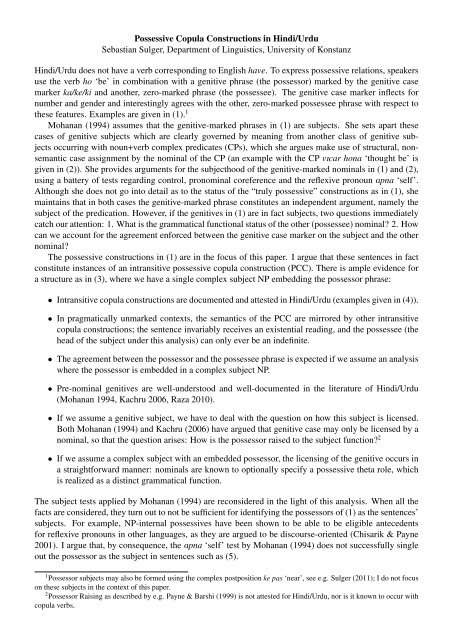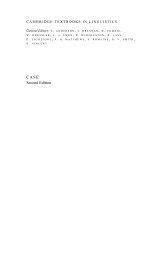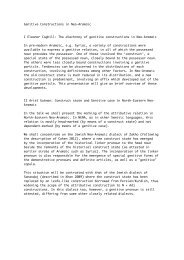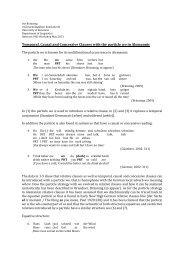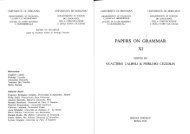Sebastian Sulger (Konstanz): Genitive subjects in Hindi-Urdu
Sebastian Sulger (Konstanz): Genitive subjects in Hindi-Urdu
Sebastian Sulger (Konstanz): Genitive subjects in Hindi-Urdu
You also want an ePaper? Increase the reach of your titles
YUMPU automatically turns print PDFs into web optimized ePapers that Google loves.
Possessive Copula Constructions <strong>in</strong> H<strong>in</strong>di/<strong>Urdu</strong><br />
<strong>Sebastian</strong> <strong>Sulger</strong>, Department of L<strong>in</strong>guistics, University of <strong>Konstanz</strong><br />
H<strong>in</strong>di/<strong>Urdu</strong> does not have a verb correspond<strong>in</strong>g to English have. To express possessive relations, speakers<br />
use the verb ho ‘be’ <strong>in</strong> comb<strong>in</strong>ation with a genitive phrase (the possessor) marked by the genitive case<br />
marker ka/ke/ki and another, zero-marked phrase (the possessee). The genitive case marker <strong>in</strong>flects for<br />
number and gender and <strong>in</strong>terest<strong>in</strong>gly agrees with the other, zero-marked possessee phrase with respect to<br />
these features. Examples are given <strong>in</strong> (1). 1<br />
Mohanan (1994) assumes that the genitive-marked phrases <strong>in</strong> (1) are <strong>subjects</strong>. She sets apart these<br />
cases of genitive <strong>subjects</strong> which are clearly governed by mean<strong>in</strong>g from another class of genitive <strong>subjects</strong><br />
occurr<strong>in</strong>g with noun+verb complex predicates (CPs), which she argues make use of structural, nonsemantic<br />
case assignment by the nom<strong>in</strong>al of the CP (an example with the CP vIcar hona ‘thought be’ is<br />
given <strong>in</strong> (2)). She provides arguments for the subjecthood of the genitive-marked nom<strong>in</strong>als <strong>in</strong> (1) and (2),<br />
us<strong>in</strong>g a battery of tests regard<strong>in</strong>g control, pronom<strong>in</strong>al coreference and the reflexive pronoun Apna ‘self’.<br />
Although she does not go <strong>in</strong>to detail as to the status of the “truly possessive” constructions as <strong>in</strong> (1), she<br />
ma<strong>in</strong>ta<strong>in</strong>s that <strong>in</strong> both cases the genitive-marked phrase constitutes an <strong>in</strong>dependent argument, namely the<br />
subject of the predication. However, if the genitives <strong>in</strong> (1) are <strong>in</strong> fact <strong>subjects</strong>, two questions immediately<br />
catch our attention: 1. What is the grammatical functional status of the other (possessee) nom<strong>in</strong>al? 2. How<br />
can we account for the agreement enforced between the genitive case marker on the subject and the other<br />
nom<strong>in</strong>al?<br />
The possessive constructions <strong>in</strong> (1) are <strong>in</strong> the focus of this paper. I argue that these sentences <strong>in</strong> fact<br />
constitute <strong>in</strong>stances of an <strong>in</strong>transitive possessive copula construction (PCC). There is ample evidence for<br />
a structure as <strong>in</strong> (3), where we have a s<strong>in</strong>gle complex subject NP embedd<strong>in</strong>g the possessor phrase:<br />
• Intransitive copula constructions are documented and attested <strong>in</strong> H<strong>in</strong>di/<strong>Urdu</strong> (examples given <strong>in</strong> (4)).<br />
• In pragmatically unmarked contexts, the semantics of the PCC are mirrored by other <strong>in</strong>transitive<br />
copula constructions; the sentence <strong>in</strong>variably receives an existential read<strong>in</strong>g, and the possessee (the<br />
head of the subject under this analysis) can only ever be an <strong>in</strong>def<strong>in</strong>ite.<br />
• The agreement between the possessor and the possessee phrase is expected if we assume an analysis<br />
where the possessor is embedded <strong>in</strong> a complex subject NP.<br />
• Pre-nom<strong>in</strong>al genitives are well-understood and well-documented <strong>in</strong> the literature of H<strong>in</strong>di/<strong>Urdu</strong><br />
(Mohanan 1994, Kachru 2006, Raza 2010).<br />
• If we assume a genitive subject, we have to deal with the question on how this subject is licensed.<br />
Both Mohanan (1994) and Kachru (2006) have argued that genitive case may only be licensed by a<br />
nom<strong>in</strong>al, so that the question arises: How is the possessor raised to the subject function? 2<br />
• If we assume a complex subject with an embedded possessor, the licens<strong>in</strong>g of the genitive occurs <strong>in</strong><br />
a straightforward manner: nom<strong>in</strong>als are known to optionally specify a possessive theta role, which<br />
is realized as a dist<strong>in</strong>ct grammatical function.<br />
The subject tests applied by Mohanan (1994) are reconsidered <strong>in</strong> the light of this analysis. When all the<br />
facts are considered, they turn out to not be sufficient for identify<strong>in</strong>g the possessors of (1) as the sentences’<br />
<strong>subjects</strong>. For example, NP-<strong>in</strong>ternal possessives have been shown to be able to be eligible antecedents<br />
for reflexive pronouns <strong>in</strong> other languages, as they are argued to be discourse-oriented (Chisarik & Payne<br />
2001). I argue that, by consequence, the Apna ‘self’ test by Mohanan (1994) does not successfully s<strong>in</strong>gle<br />
out the possessor as the subject <strong>in</strong> sentences such as (5).<br />
1Possessor <strong>subjects</strong> may also be formed us<strong>in</strong>g the complex postposition ke pas ‘near’, see e.g. <strong>Sulger</strong> (2011); I do not focus<br />
on these <strong>subjects</strong> <strong>in</strong> the context of this paper.<br />
2Possessor Rais<strong>in</strong>g as described by e.g. Payne & Barshi (1999) is not attested for H<strong>in</strong>di/<strong>Urdu</strong>, nor is it known to occur with<br />
copula verbs.
Semantically, the genitive phrases are not conf<strong>in</strong>ed to possession, but may realize different relations<br />
between the nom<strong>in</strong>als (cf. Barker 1995, Chisarik & Payne 2001). Among them, <strong>in</strong> H<strong>in</strong>di/<strong>Urdu</strong>, are<br />
attribution (6a) and quality (6b) relations. Therefore, they are argued to l<strong>in</strong>k to unrestricted functions <strong>in</strong><br />
the sense that they may realize a variety of different thematic roles.<br />
I implement the analysis of H<strong>in</strong>di/<strong>Urdu</strong> PCCs <strong>in</strong> the theoretical framework of Lexical-Functional<br />
Grammar (LFG, Dalrymple 2001). The copula is an <strong>in</strong>transitive verb select<strong>in</strong>g a s<strong>in</strong>gle thematic role,<br />
a theme, <strong>in</strong> its argument structure. This theme is l<strong>in</strong>ked to the subject function of the ma<strong>in</strong> clause as<br />
per the subject condition (Dalrymple 2001, Bresnan 2001). When a possessor is realized, an additional<br />
“theme” role is selected by the theme via a lexical process; this “<strong>in</strong>ternal” theme is l<strong>in</strong>ked to the subject<br />
function <strong>in</strong>side the ma<strong>in</strong> clause’s subject (see (7) and the result<strong>in</strong>g functional structure <strong>in</strong> (8)). In LFG, the<br />
SUBJ function is taken to be both discourse-oriented and unrestricted, reflect<strong>in</strong>g the two salient properties<br />
of the H<strong>in</strong>di-<strong>Urdu</strong> genitive discussed above. The agreement between the possessor and the possessum can<br />
then be taken care of by standard LFG techniques. In sum, the analysis I propose expla<strong>in</strong>s the facts <strong>in</strong> a<br />
more natural manner and readily presents an explanation for the agreement patterns and semantic effects<br />
observed.<br />
(1) a. nadya=ka/*=ki mAkan hE<br />
Nadya.F.Sg.Obl=Gen.M.Sg.Nom/*=Gen.F.Sg.Nom house.M.Sg.Nom be.Pres.3P.Sg<br />
lit. ‘There is a house of Nadya’s.’ = ‘Nadya has/owns a house.’<br />
b. nadya=ki/*=ka Almari hE<br />
Nadya.F.Sg.Obl=Gen.F.Sg.Nom/*=Gen.M.Sg.Nom cupboard.F.Sg.Nom be.Pres.3P.Sg<br />
lit. ‘There is a cupboard of Nadya’s.’ = ‘Nadya has/owns a cupboard.’<br />
(2) ram=ka g h Ar laut.-ne=ka vIcar<br />
Ram.M.Sg.Obl=Gen.M.Sg.Nom home.M.Sg.Nom return-Inf.M.Sg.Obl thought.M.Sg.Nom<br />
t h -a<br />
be.Past-M.Sg<br />
‘Ram was th<strong>in</strong>k<strong>in</strong>g of return<strong>in</strong>g home.’ Mohanan (1994), p. 180<br />
(3) [[nadya=ka]GEN mAkan]SUBJ hE<br />
(4) a. xUda hE<br />
god.M.Sg.Nom be.Pres.3P.Sg<br />
‘There is a god.’<br />
b. pArti hE<br />
party.M.Sg.Nom be.Pres.3P.Sg<br />
‘There is a party.’<br />
(5) ram=ke Apna ek b h i b�t.a nAhĩ t h -a<br />
Ram.M.Sg.Obl=Gen.M.Sg.Obl self.M.Sg.Nom one even son.M.Sg.Nom not be.Past-M.Sg<br />
lit. ‘There was not even one son of Ram’s own.’ = ‘Ram didn’t have even one son of his own.’<br />
Mohanan (1994), p. 181<br />
(6) a. lahor=ka Sehr<br />
Lahore=Gen.M.Sg.Nom city.M.Sg.Nom<br />
‘the city of Lahore’<br />
b. xof=ka lAmha<br />
fear.M.Sg.Nom=Gen.M.Sg.Nom moment.M.Sg.Nom<br />
‘moment of fear’
(7) L<strong>in</strong>k<strong>in</strong>g analysis:<br />
ho < th < th > ><br />
| |<br />
[-o, -r] [-o, -r]<br />
| |<br />
SUBJ SUBJ<br />
(8) ⎡<br />
⎤<br />
PRED ‘ho’<br />
⎢ ⎡<br />
⎤ ⎥<br />
⎢ PRED ‘mAkan’ ⎥<br />
⎢ ⎢ ⎡<br />
⎤ ⎥<br />
⎢ ⎢<br />
⎥<br />
⎢ ⎢ PRED ‘nadya’ ⎥<br />
⎢SUBJ<br />
⎢<br />
⎢ ⎢SUBJ<br />
⎣ ⎦ ⎥<br />
⎥<br />
⎢ ⎢ CASE genitive ⎥<br />
⎢ ⎣<br />
⎦ ⎥<br />
⎢ CASE nom<strong>in</strong>ative<br />
⎥<br />
⎣<br />
⎦<br />
TENSE present<br />
Selected References<br />
Barker, Chris. 1995. Possessive Descriptions. CSLI Publications.<br />
Bresnan, Joan. 2001. Lexical-Functional Syntax. Blackwell.<br />
Chisarik, Erika and John Payne. 2001. Modell<strong>in</strong>g Possessor Constructions In LFG: English and Hungarian.<br />
In Butt, Miriam and Tracy Holloway K<strong>in</strong>g, eds., Nom<strong>in</strong>als: Inside and Out. CSLI Publications.<br />
Dalrymple, Mary. Lexical Functional Grammar, volume 34 of Syntax and Semantics. Academic Press,<br />
2001.<br />
Kachru, Yamuna. 2006. H<strong>in</strong>di. John Benjam<strong>in</strong>s.<br />
Mohanan, Tara. 1994. Argument Structure <strong>in</strong> H<strong>in</strong>di. CSLI Publications.<br />
Payne, Doris L. and Immanuel Barshi. 1999. External Possession: what, where, how and why. In Payne<br />
& Barshi, eds., External Possession. John Benjam<strong>in</strong>s.<br />
Raza, Ghulam. 2010. Analyz<strong>in</strong>g the Structure of <strong>Urdu</strong> NPs with Multiple <strong>Genitive</strong>s. Proceed<strong>in</strong>gs of the<br />
Conference on Language & Technology 2010, Islamabad, Pakistan.<br />
<strong>Sulger</strong>, <strong>Sebastian</strong>. 2011. A Parallel Analysis of have-Type Copular Constructions <strong>in</strong> two have-Less Indo-<br />
European Languages. Onl<strong>in</strong>e Proceed<strong>in</strong>gs of the LFG11 Conference, Hong Kong University, Hong Kong.<br />
CSLI Publications.


